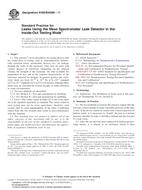Potřebujeme váš souhlas k využití jednotlivých dat, aby se vám mimo jiné mohly ukazovat informace týkající se vašich zájmů. Souhlas udělíte kliknutím na tlačítko „OK“.
ASTM E493/E493M-11
Standard Practice for Leaks Using the Mass Spectrometer Leak Detector in the Inside-Out Testing Mode
Automaticky přeložený název:
Standardní praxe těsnost hmotnostního spektrometru netěsností v naruby testovací režim
NORMA vydána dne 1.7.2011
Informace o normě:
Označení normy: ASTM E493/E493M-11
Poznámka: NEPLATNÁ
Datum vydání normy: 1.7.2011
Kód zboží: NS-46976
Počet stran: 3
Přibližná hmotnost: 9 g (0.02 liber)
Země: Americká technická norma
Kategorie: Technické normy ASTM
Kategorie - podobné normy:
Anotace textu normy ASTM E493/E493M-11 :
Keywords:
bell jar leak test, bomb mass spectrometer leak test, helium leak test, helium leak testing, leak testing, mass spectrometer leak testing, sealed object mass spectrometer leak test, Bell jar leak test, Bomb mass spectrometer leak test, Helium leak testing, Inside-out mode, Leak testing--mass spectrometer leak detector (MSLD), Mass spectrometer leak detector (MSLD), Probe methods, Sealed object mass spectrometer leak test, ICS Number Code 19.100 (Non-destructive testing)
Doplňující informace
| Significance and Use | ||||
|
Methods A or B are useful in testing hermetically-sealed devices with internal volumes. Maximum acceptable leak rates have been established for microelectronic devices to assure performance characteristics will not be affected by in-leakage of air, water vapor or other contaminants over the projected life expected. Care must be taken to control the bombing pressure, bombing time and dwell time after bombing or the results can vary substantially. |
||||
| 1. Scope | ||||
|
1.1 This practice covers procedures for testing devices that are sealed prior to testing, such as semiconductors, hermetically enclosed relays, pyrotechnic devices, etc., for leakage through the walls of the enclosure. They may be used with various degrees of sensitivity (depending on the internal volume, the strength of the enclosure, the time available for preparation of test, and on the sorption characteristics of the enclosure material for helium). In general practice the sensitivity limits are from 10−10 to 10−6 Pa m3/s (10−9 standard cm3/s to 10−5 standard cm3/s at 0°C) for helium, although these limits may be exceeded by several decades in either direction in some circumstances. 1.2 Two test methods are described: 1.2.1 Test Method A—Test part preparation by bombing. 1.2.2 Test Method B—Test part preparation by prefilling. 1.3 Units—The values stated in either SI or std-cc/sec units are to be regarded separately as standard. The values stated in each system may not be exact equivalents: therefore, each system shall be used independently of the other. Combining values from the two systems may result in non-conformance with the standard. 1.4 This standard does not purport to address all of the safety concerns, if any, associated with its use. It is the responsibility of the user of this standard to establish appropriate safety and health practices and determine the applicability of regulatory limitations prior to use. |
||||
| 2. Referenced Documents | ||||
|




 Cookies
Cookies
